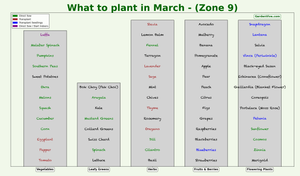
If you want to grow fast-growing trees for shade and ask for suggestions from your near and dear ones or even some experts, they will say "Do you know that fast-growing trees are weaker?". This question made me write this article. Nature is amazing and we have plenty of fast-growing shade trees that can perform well in Zone 9 (Strong and resilient). In this article, I will share a list of fast-growing shade trees for Zone 9.
Zone 9 Fast Growing Shade Trees List
| Tree Name | Height (Mature) | Growth Rate (per Year) | Benefits |
|---|---|---|---|
| Hybrid Poplar | 40-50 feet | 5-8 feet per year | One of the fastest-growing trees, great for quick shade |
| Lombardy Poplar | 40-60 feet | 6 feet per year | Fast growth, excellent for windbreaks and quick shade |
| Burflower Tree (Kadamba) | 40-50 feet | 3-6 feet per year | Fast-growing, fragrant flowers, dense shade |
| Weeping Willow | 30-50 feet | 3-4 feet per year | Grows quickly in moist areas, graceful appearance |
| Red Maple | 40-60 feet | 2-3 feet per year | Vibrant fall color, fast growth, excellent shade |
| Green Ash | 50-60 feet | 2-3 feet per year | Tolerates various soils, provides ample shade |
| American Sycamore | 70-100 feet | 2-3 feet per year | Large canopy, fast growth, excellent for shade |
It's hard to find fast-growing shade trees for Zone 9.
Note: Hybrid Poplar and Lombardy love cooler regions but their USDA hardiness zone is 3 to 9. So you can consider these trees. ( I would personally avoid these unless I am desperate to get shades as fast as I can)
If you wish to make your porch beautiful read: Best Low Maintenance Porch Plants for Zone 9
If you wish you can also consider Live Oak. But it's difficult to clear the ground due to a large amount of leaves, acorns, and the throughout the year.
Burflower is a great choice but I am not sure if you can find this tree in the local nurseries. It is really fast growing. My Aunt planted this in South Florida 5 years back and the tree is huge now. No one can beat the shade.
Few more trees that I would consider but did not put on the list:
- Ice Cream Bean Tree - It can grow up to 25 feet.
- Royal Poinciana - But I did not put this on the list due to its aggressive surface roots. It can damage nearby structures, like sidewalks, driveways, foundations, and underground pipes.
- Jamaican fruit trees - Hurricanes can damage the tree if saltwater is flooded. (Check what to do if saltwater flooded in your garden )

Fruit trees can give shade as well. (For Zone 9)
If you want to get bonus fruits along with some sort of shade, you can consider the below list of trees.
(Kindly do not consider Papaya if you want to have a strong tree.)
| Tree Name | Height (Mature) | Growth Rate (per Year) | Benefits |
|---|---|---|---|
| Moringa Tree (Moringa oleifera) | 15-40 feet | 5-10 feet per year | Very fast-growing, offers dappled shade, edible pods and leaves |
| Fig Tree (Ficus carica) | 15-30 feet | 2-3 feet per year | Provides dense leaves for shade, produces sweet figs |
| Mulberry Tree (Morus spp.) | 30-50 feet | 2-3 feet per year | Broad shade, edible mulberries, fast-growing and low-maintenance |
| Papaya Tree (Carica papaya) | 10-30 feet | 3-4 feet per year | Fast-growing, moderate shade, delicious papayas |
| Loquat Tree (Eriobotrya japonica) | 15-30 feet | 2-3 feet per year | Dense shade, produces edible loquats |
| Peach Tree (Prunus persica) | 15-25 feet | 2-3 feet per year | Moderate shade, juicy peaches, quick growth |
| Avocado Tree (Persea americana) | 30-40 feet | 2-3 feet per year | Ample shade, nutritious avocados, fast-growing |
| Guava Tree (Psidium guajava) | 10-30 feet | 2-3 feet per year | Moderate shade, fragrant fruits, fast-growing |
| Persimmon Tree (Diospyros kaki) | 30-50 feet | 2-3 feet per year | Broad shade, vibrant orange fruits, fast-growing |
| Plum Tree (Prunus domestica) | 20-25 feet | 2-4 feet per year | Moderate to dense shade, produces sweet plums |
If you are worried about Hurricanes or strong storms then you can check: Florida Native Trees and Shrubs that can withstand storms.
Palm trees as shade trees
Are you a palm lover? Don't worry, I have a list for you as well.
| Palm Tree Name | Height (Mature) | Growth Rate (per Year) | Benefits |
|---|---|---|---|
| Canary Island Date Palm (Phoenix canariensis) | 40-60 feet | 1-2 feet per year | Majestic appearance, dense canopy, ornamental fruit |
| Windmill Palm (Trachycarpus fortunei) | 20-40 feet | 1 foot per year | Cold-hardy, compact size, attractive fan-like leaves |
| Pindo Palm (Butia capitata) | 15-20 feet | 1-2 feet per year | Cold-hardy, edible fruit, elegant arching fronds |
| Sabal Palm (Sabal palmetto) | 40-50 feet | 6 inches to 1 foot per year | Native to the U.S., drought-tolerant, provides shade |
| Mediterranean Fan Palm (Chamaerops humilis) | 10-15 feet | 6 inches to 1 foot per year | Cold-hardy, clumping growth habit, drought-resistant |
| Queen Palm (Syagrus romanzoffiana) | 40-50 feet | 2-3 feet per year | Graceful fronds, tropical appearance, low maintenance |
| Mexican Fan Palm (Washingtonia robusta) | 70-100 feet | 3-4 feet per year | Fast-growing, dramatic height, iconic silhouette |
| Bismarck Palm (Bismarckia nobilis) | 30-60 feet | 1-2 feet per year | Unique silver-blue foliage, drought-tolerant, striking visual appeal |
| Foxtail Palm (Wodyetia bifurcata) | 30-40 feet | 2-3 feet per year | Distinctive foliage, low maintenance, ornamental fruit |
| Lady Palm (Rhapis excelsa) | 6-12 feet | 1 foot per year | Compact size, ideal for small spaces, low light tolerance |
Note: You need to work hard to maintain good shape of a few palm trees. You can hire someone who works this type of work like pruning the lower dead leaves.






